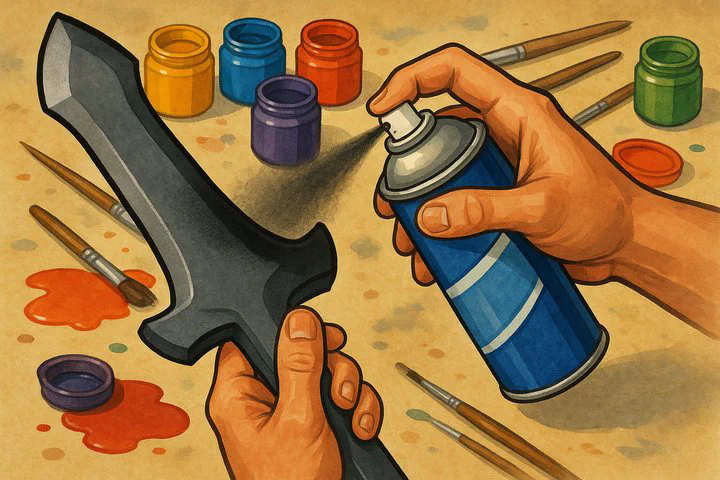Is Plastidip a Good Primer for Foam

Is Plastidip a Good Primer for Foam?
Are you thinking about sealing your next foam prop or costume piece, but you’re not sure which primer to pick? Many makers type the same question into their search bar: is plastidip a good primer for foam? In this guide, we’ll look at what Plastidip does, how well it takes paint, and how it stacks up against other sealers like XLPA. By the end, you’ll know exactly which primer works best for your project.
1. Why Use Plastidip as a Primer?
Plastidip is a flexible rubber coating sold in spray cans or dip form. Though people first used it on tool handles, crafters soon learned it sticks nicely to EVA and craft foam.
Why reach for Plastidip?
• It seals tiny air pockets so paint sits on top instead of soaking in.
• The rubber finish bends with armor and props, so painted layers don’t crack.
• It dries to a smooth skin that shrugs off light rain and bumps.
Still wondering is plastidip a good primer for foam in every case? Keep in mind:
• The spray has a strong smell—use it outdoors or in a booth.
• It costs more than white glue or Mod Podge.
• Thick coats can stay tacky in hot weather, so spray light layers.
2. How Paintable Is Plastidip on Foam?
A top question in forums is, “how paintable is plastidip if I use that to seal the foam?” Good news: once the coating cures, most acrylics, spray paints, and airbrush colors stick well.
Follow these quick steps:
- Spray 2–3 thin coats, waiting 30 minutes between passes.
- Let the final coat cure 24 hours. It should feel dry, not sticky.
- Lightly scuff with a gray Scotch-Brite pad to add “tooth.”
- Wipe away dust, then paint in light layers.
If paint peels later, check for these fixes:
• Coats were too thick—spray lighter next time.
• Plastidip wasn’t fully cured—wait the full day.
• Foam had grease or dust—wash and dry before sealing.
3. Alternatives to Plastidip for Priming Foam
I’ve been recommended XLPA, if anyone has experience or advice between the two. Let’s compare:
XLPA (Cross-Link Poly Acrylic)
• Brushed on, so no overspray.
• Dries to a harder shell but still flexes a bit.
• Needs 48 hours to cure before paint.
Budget Options
- PVA glue watered 1:1 – super cheap, easy to find, can crack on sharp bends.
- Mod Podge – thicker than PVA, adds mild flex, sands smooth.
- Flexbond – theater glue that stays bendy; great for large armor.
- Acrylic gesso – sands like a dream but can chip unless mixed with fabric medium.
Test each on a scrap first. You’ll soon see when is plastidip a good primer for foam and when another product wins on price, hardness, or odor.
4. Priming Tricks for Plastic Bases
You might ask, “any way I should prime the plastic base?” Plastic is slick, so sanding helps primer grip.
Step-by-step:
- Sand with 220-grit paper.
- Wipe dust with rubbing alcohol.
- Spray a plastic-safe primer or a thin Plastidip coat.
Maybe you’re thinking, “I found a plastic mask at Spirit I was thinking I could build on.” Try this:
• Sand and clean the mask.
• Spray a light layer of Plastidip; let it dry overnight.
• Glue foam details on top.
• Seal new foam pieces as you did before.
The light sanding and primer bond both materials so paint won’t peel.
5. Creative Ways to Use Plastidip
Plastidip isn’t just for sealing:
• Dip wire jewelry edges for soft, colorful tips.
• Spray uneven coats, press crumpled foil into the wet layer, and make dragon-scale textures.
• Add grip to homemade tools or 3D-printed handles.
• Mix tint into clear Plastidip for custom colors or glow effects.
Share your successes in communities like r/CosplayHelp or r/Leatherworking so others can learn from you!
6. Wrap-Up
So, is plastidip a good primer for foam? For many crafters, the answer is yes: it seals pores, stays flexible, and takes paint like a champ. Still, factors like cost, smell, and cure time may steer you toward XLPA or classic PVA glue. No matter which primer you choose, test on a scrap first, follow thin-coat rules, and have fun turning plain foam into show-stopping creations. Happy crafting!